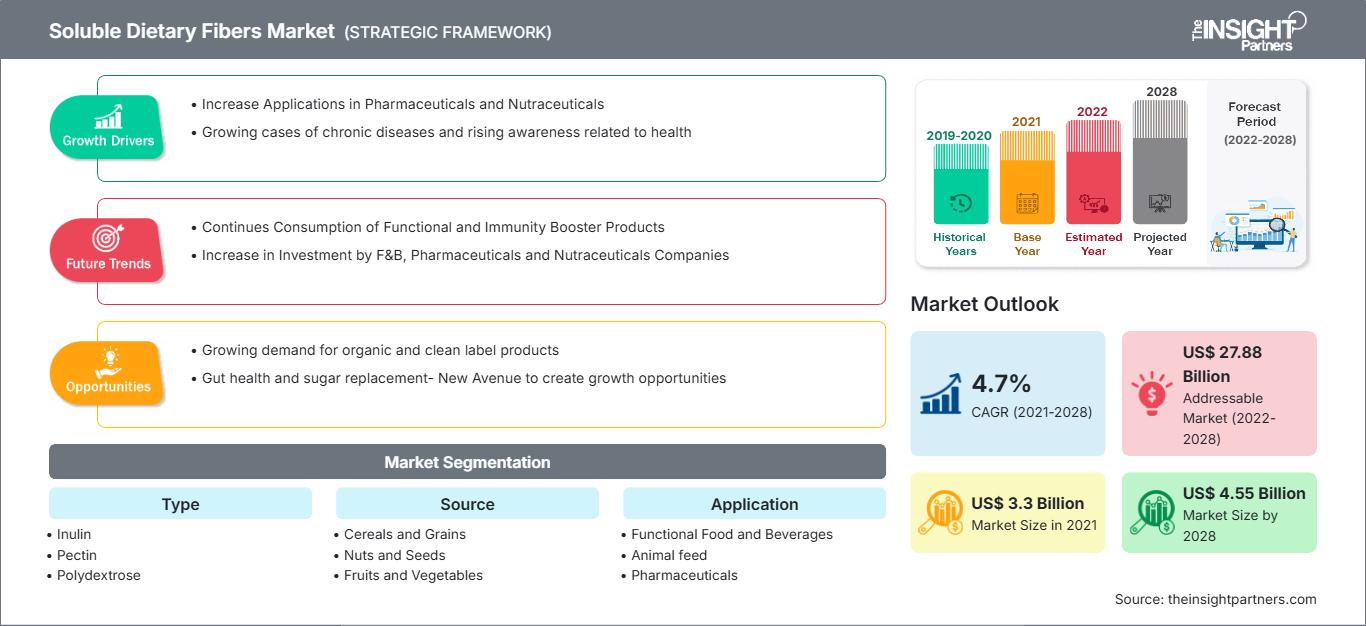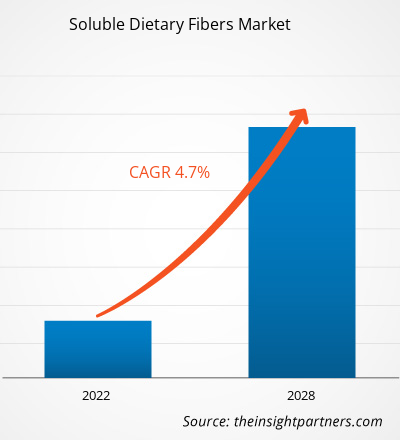可溶性膳食纤维市场预计将从2021年的33.0131亿美元增长到2028年的45.4647亿美元;预计2021年至2028年的复合年增长率为4.7%。
可溶性膳食纤维是指在水中具有分散性并形成凝胶状物质的纤维。这些纤维在胃肠道中形成粘稠的凝胶,并具有减缓食物从胃部输送到肠道的过程的能力。这类纤维主要来源于水果和蔬菜、豆类和燕麦。可溶性膳食纤维有助于促进结肠健康,刺激肠道中的双歧杆菌或乳酸杆菌,促进冠状动脉健康,并降低胆固醇和血糖水平。消费者生活方式的转变以及膳食纤维作为功能性食品成分的日益普及,推动了对可溶性膳食纤维的需求。此外,可溶性膳食纤维在食品饮料、医药和营养保健品以及动物饲料等各个行业的应用范围不断扩大,预计将在未来几年为市场增长提供动力。
2021年,亚太地区占据了全球可溶性膳食纤维市场的最大收入份额。亚太地区可溶性膳食纤维的高消费量归因于人们日益增强的健康意识。制造业中心的存在以及食品饮料加工行业对可溶性膳食纤维日益增长的需求推动了该地区市场的增长。此外,消费者生活方式的改变、食品饮料行业的蓬勃发展以及全球市场参与者的市场渗透预计将在未来几年推动市场增长。此外,持续的研发以及医药和营养保健品、动物饲料等行业的增长,使得可溶性膳食纤维在该区域市场得到广泛应用。
自定义此报告以满足您的要求
您将免费获得任何报告的定制,包括本报告的部分内容,或国家级分析、Excel 数据包,以及为初创企业和大学提供超值优惠和折扣
可溶性膳食纤维市场: 战略洞察

-
获取本报告的主要市场趋势。这个免费样本将包括数据分析,从市场趋势到估计和预测。
新冠疫情对可溶性膳食纤维市场的影响
持续的新冠疫情彻底改变了食品饮料行业的现状,并对可溶性膳食纤维市场的增长产生了负面影响。为遏制病毒传播而采取的措施使形势更加恶化,并影响了多个工业部门的增长。由于国内和国际边界的突然关闭,运营效率的突然扭曲和价值链的中断对市场造成了冲击。由于无限期封锁和临时隔离,从供应商处采购原材料的中断以及生产基地的暂时关闭,影响了疫情期间市场的增长。然而,尽管疫情影响了供应链运营,但疫情也激发了消费者对健康生活的需求,因此,消费者将注意力转向了营养食品。例如,根据《营养洞察》(Nutrition Insight)2020年6月发表的一篇文章,疫情为膳食纤维市场创造了增长机会,人们越来越倾向于选择有机、天然和清洁标签产品,同时肠道健康和糖替代品也成为关注的焦点。根据世界卫生组织(WHO)的健康指南,每天摄入25克膳食纤维对于增强抵抗微生物的免疫力至关重要。从燕麦、大麦、豌豆、苹果、柑橘类水果和土豆中提取的可溶性纤维,以及化学工程硫酸化葡聚糖,具有缓解便秘和强大抗病毒能力的潜力。此外,根据国际益生元和益生元科学协会(ISAPP)的说法,菊粉和低聚果糖被归类为重要的植物性益生元可溶性膳食纤维,它们能够促进肠道健康,这在当前疫情期间至关重要。例如,根据 FoodIngredientsFirst 发表的一篇文章,消费者积极参与食用有机菊苣根纤维。这种纤维由可溶性菊粉纤维组成,有助于促进肠道健康、心理健康和免疫力。因此,随着功能性和增强免疫力产品的消费趋势日益增长,预计疫情后对可溶性膳食纤维的需求将蓬勃发展。此外,随着各经济体计划恢复运营,预计全球对可溶性膳食纤维的需求也将上升。食品和饮料行业对可溶性膳食纤维的需求不断增长。饮料、药品和保健食品、动物饲料以及其他行业的蓬勃发展,加上知名制造商的大量投资,预计将推动可溶性膳食纤维市场的发展。
市场洞察
可溶性膳食纤维在药品和保健食品中的应用日益广泛
可溶性膳食纤维可用作食品添加剂,还能促进结肠健康,刺激肠道双歧杆菌或乳酸杆菌生长,维护冠状动脉健康,降低胆固醇,促进葡萄糖代谢。此外,可溶性膳食纤维有助于控制体重,降低患心血管疾病的风险。水溶性膳食纤维被认为是膳食纤维的重要形式之一。它由菊粉、β-葡聚糖、聚葡萄糖、果胶、低聚果糖、低聚半乳糖和玉米纤维组成,有助于提升所添加食品和饮料产品的营养成分。
例如,罗盖特公司 (Roquette) 旗下品牌“NUTRIOSE”为食品、制药和营养保健行业提供非粘性可溶性纤维。NUTRIOSE 由小麦和玉米等谷物制成,具有高效的消化耐受性。同样,高端运动和健康营养公司 Steadfast Nutrition 旗下品牌 Tri Fiber 提供以可溶性膳食纤维为基础的膳食补充剂粉。可溶性膳食纤维有助于维持肠道健康,平衡血糖和血脂。此外,该产品有助于控制食欲激素,促进排便,并控制体内甘油三酯水平,通过控制胆固醇水平来改善血脂状况。抗性麦芽糊精的改善效果已得到特定保健用途食品(FOSHU)的认可。该产品可供上班族、减肥人士、运动员和健身爱好者以及患者食用。同样,Benefiber 和 Metamucil 也是非处方 (OTC) 可溶性膳食纤维补充剂。Benefiber 已获得美国食品药品监督管理局 (FDA) 批准作为膳食纤维补充剂,其活性成分为小麦糊精。它有助于肠道吸收水分,并刺激蠕动或肠道肌肉的重复收缩和舒张。Metamucil 由车前子壳制成,车前子壳是从印度草药车前子(Plantago ovata)的种子中提取的。人们对健康的日益关注,以及人们对可溶性膳食纤维健康益处的认识不断提高,以及慢性病发病率的不断上升,促使制造商生产基于可溶性膳食纤维的营养保健品和药品,预计这将推动全球市场对可溶性膳食纤维的需求。
类型洞察
根据类型,可溶性膳食纤维市场细分为菊粉、果胶、聚葡萄糖、β-葡聚糖等。2021年,菊粉占据市场主导地位。菊粉是一种从多种植物中提取的可溶性纤维。各种水果、蔬菜和草本植物,包括小麦、洋葱、大蒜、香蕉、韭菜、朝鲜蓟、菊苣根和芦笋,都用于提取菊粉。在药用方面,菊粉通常从菊苣根中提取。菊粉用于减肥、治疗便秘、腹泻和糖尿病。它也被用作治疗药物输送的工具。菊粉补充剂有胶囊和粉末两种形式。菊粉用于各种产品,包括乳制品、面包、谷物棒、保健营养品、新生儿营养品、饮料、糖果、冰淇淋和咸味食品。许多食品制造商在加工产品中添加菊粉,以提高食品中的益生元含量,替代食品中的脂肪和糖,并提高食品的健康益处,因为它有益于肠道健康。菊粉可以改善口感和质地。由于菊粉具有重要的物理化学性质,高浓度的菊粉可以改变产品的质地。
来源洞察
根据来源,可溶性膳食纤维市场可细分为谷物和谷类、水果和蔬菜以及其他。2021 年,谷物和谷类占据市场主导地位。小麦、大麦、燕麦、黑麦和玉米等不同类型的谷物和谷类都被用作生产可溶性膳食纤维的来源。麦麸是全麦粒的外层,是益生元的极佳来源。麦麸有助于减少消化问题,例如胀气、痉挛和腹痛。燕麦富含可溶性纤维。燕麦可用于制作早餐麦片、面包、司康饼、燕麦饼或水果酥。它们含有β-葡聚糖,有助于控制血糖水平。大麦是另一种富含膳食纤维的谷物作物,尤其是可溶性纤维。大麦含有约3.5%至5.9%的可溶性纤维β-葡聚糖。
应用洞察
根据应用,可溶性膳食纤维市场细分为食品和饮料、动物营养、药品和保健食品以及其他领域。2021年,食品和饮料领域占据市场主导地位。食品和饮料行业使用各种类型的可溶性膳食纤维。这些可溶性膳食纤维被用作许多应用的配料,包括乳制品、烘焙食品、蛋白棒、谷物棒、饮料、糖果、冰淇淋、甜点、软饮料、面包和谷物制品。菊粉、聚葡萄糖、果胶和糊精等可溶性膳食纤维可用于替代食品中的脂肪和糖。菊粉无色,可用于多种食品,且不会影响其外观、质地或风味。果胶在果冻、果酱和柑橘酱的商业生产中用作增稠剂。可溶性纤维用于食品中,可以改善口感和质地,同时还能带来诸多健康益处。
可溶性膳食纤维市场的主要参与者包括 Beneo Gmbh、Roquette Frères、Ingredion Incorporated、Tate & Lyle Plc 和 Cargill, Incorporated。这些市场参与者高度重视开发高质量和创新的产品。
可溶性膳食纤维
可溶性膳食纤维市场区域洞察
The Insight Partners 的分析师已详尽阐述了预测期内影响可溶性膳食纤维市场的区域趋势和因素。本节还讨论了北美、欧洲、亚太地区、中东和非洲以及南美和中美洲的可溶性膳食纤维市场细分和地域分布。
可溶性膳食纤维市场报告范围
| 报告属性 | 细节 |
|---|---|
| 市场规模 2021 | US$ 3.3 Billion |
| 市场规模 2028 | US$ 4.55 Billion |
| 全球复合年增长率 (2021 - 2028) | 4.7% |
| 历史数据 | 2019-2020 |
| 预测期 | 2022-2028 |
| 涵盖的领域 |
By 类型
|
| 覆盖地区和国家 |
北美
|
| 市场领导者和主要公司简介 |
|
可溶性膳食纤维市场参与者密度:了解其对业务动态的影响
可溶性膳食纤维市场正在快速增长,这得益于终端用户需求的不断增长,而这些需求的驱动因素包括消费者偏好的演变、技术进步以及对产品益处的认知度的提升。随着需求的增长,企业正在扩展产品线,不断创新以满足消费者需求,并抓住新兴趋势,从而进一步推动市场增长。

- 获取 可溶性膳食纤维市场 主要参与者概述
报告重点
- 可溶性膳食纤维市场不断发展的行业趋势,帮助参与者制定有效的长期战略
- 发达市场和发展中市场采用的业务增长战略
- 2019 年至 2028 年可溶性膳食纤维市场的定量分析
- 全球可溶性膳食纤维需求估算
- PEST 分析,说明行业买家和供应商的效率
- 了解竞争激烈的市场形势
- 市场趋势和前景,以及推动和抑制可溶性膳食纤维市场增长的因素
- 通过强调支撑商业利益的市场策略来协助决策过程,从而促进市场增长
- 市场的详细概述和细分,以及可溶性膳食纤维行业动态
- 各地区可溶性膳食纤维市场规模及增长前景
可溶性膳食纤维市场,按类型
- 菊粉
- 果胶
- 聚葡萄糖
- β-葡聚糖
- 其他
可溶性膳食纤维市场,按来源
- 谷物和谷类
- 水果和蔬菜
- 其他
可溶性膳食纤维市场,按应用
- 食品和饮料
- 动物营养
- 药品和保健食品
- 其他
公司简介
- 嘉吉公司
- 凯里集团
- 宜瑞公司
- Nexira
- Roquette Freres
- ADM
- Tate And Lyle PLC
- IFF Nutrition & Co.生物科学
- Beneo GMBH
- Cosucra
- 历史分析(2 年)、基准年、预测(7 年)及复合年增长率
- PEST和SWOT分析
- 市场规模、价值/数量 - 全球、区域、国家
- 行业和竞争格局
- Excel 数据集
近期报告
客户评价
购买理由
- 明智的决策
- 了解市场动态
- 竞争分析
- 客户洞察
- 市场预测
- 风险规避
- 战略规划
- 投资论证
- 识别新兴市场
- 优化营销策略
- 提升运营效率
- 顺应监管趋势






















 获取免费样品 - 可溶性膳食纤维市场
获取免费样品 - 可溶性膳食纤维市场